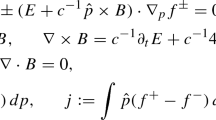Summary
The paper deals with two kinds of infinities occurring in Prigogine’s master equation when it is applied to a system containing charged particles (one electron andN ions) and radiation. The first kind is caused by the presence of the radiation field since the usual Hamiltonian for an electron and a radiation field necessarily contains also the self-field of the electron, which is infinite on the electron’s world line. We then analyse how precisely this infinity enters into the formalism. The analysis leads to a prescription for rewriting the Liouville operator which allows relativistic and radiation reaction effects to be approximately included and which yields a theory without divergences due to the presence of a radiation field. Another kind of infinity is shown to be present. It occurs upon integrating over the particle co-ordinates, as is necessary for many applications. The immediate cause of this infinity is shown to be an asymptotic time integration employed to derive the master equation. However, reasons are given to show that the asymptotic time integration cannot simply be replaced by some other formalism leading to finite results; the convergence of the series for the momentum distribution function is indeed poor for small relative velocities between electron and ions, so that only the sum of a large number of terms in the series can provide a correct (and finite) result for small velocities.
Riassunto
In questo articolo si considerano i due tipi di infiniti che si presentano nell’equazione principale di Prigogine quando la si applichi ad un sistema contenente particelle cariche (un elettrone edN ioni) e radiazione. Il primo tipo è causato dalla presenza del campo di radiazione poiché la solita hamiltoniana per un elettrone ed un campo di radiazione necessariamente contiene anche l’autocampo dell’elettrone, che è infinito sulla linea d’universo dell’elettrone. Si analizza in qual modo questo infinito entri nel formalismo. L’analisi porta ad una prescrizione per riscrivere l’operatore di Liouville che che permette l’inclusione approssimativa di effetti relativistici e di reazione da radiazione e che dà una teoria senza le divergenze dovute alla presenza di un campo di radiazione. Si dimostra che è presente un altro tipo di infinito. Esso si presenta in seguito all’integrazione sulle coordinate della particella, che è necessaria per molte applicazioni. La causa immediata di questo infinito si dimostra essere una integrazione asintotica rispetto al tempo usata per dedurre l’equazione principale. Comunque, si espongono le ragioni per dimostrare che l’integrazione asintotica rispetto al tempo non può essere semplicemente rimpiazzata da qualche altro formalismo che porti a risultati finiti; la convergenza della serie per la funzione di distribuzione della quantità di moto è infatti scarsa per velocità relative piccole fra elettrone e ioni, cosicché solo la somma di un gran numero di termini nella serie può fornire un risultato corretto (e finito) per piccole velocità.
Реэюме
В зтой статье рассматриваются два вида бесконечностей, встречаюшихся в основном уравнении Пригожина, когда зто уравнение применяется к системе, содержашей эаряженные частицы (один злектрон иN ионов) и иэлучение. Первый вид обусловлен наличием поля иэлучения, так как обычный Гамильтониан для злектрона и поля иэлучения неиэбежно содержит также собственное поле злектрона, которое является бесконечным на мировой линии злектрона. В статье аналиэируется, как именно зта бесконечность входит в формалиэм. Этот аналиэ приводит к рецепту для написания оператора Лиувилля, который поэволяет включить приближенно релятивистские зффекты и влияние реакции иэлучения, и зто дает теорию беэ расходимостей, обусловленных наличием пола иэлучения. Покаэывается, что сушествует другой вид бесконечности. Он встречается при интегрировании по координатам частиц, которое необходимо для многих приложений. Отмечается, что непосредственная причина зтой бесконечности представляет асимптотическое временное интегрирование, испольэованное при выводе основного уравнения. Однако, приводястя доводы, чтобы покаэать, что асимптотическое временное интегрирование не может быть просто эаменено некоторым другим формалиэмом, приводяшим к конечным реэультатам; сходимость ряда для импульсной функции распределения в действительности является слабой для относительно малых скоростей между злектронами и ионами, так что только сумма больщото числа членов в ряду может дать правильный (и конечный) реэультат для малых скоростей.
Similar content being viewed by others
References
I. Prigorine:Nonequilibrium Statistical Mechanics (New York, 1962).
R. Balescu:Statistical Mechanics of Charged Particles (New York, 1963).
I. Prigogine andB. Leaf:Physica,25, 1067 (1959).
F. Henin:Physica,29, 1233 (1963).
A. Mangeney:Physica,30, 461 (1964).
P. Mallozzi andH. Margenau:Ann. of Phys.,38, 117 (1966).
I. Prigogine andF. Henin:Physica,28, 667 (1962);29, 286 (1963).
E. A. Frieman:Journ. Math. Phys.,4, 410 (1963).
G. Sandri:Ann. of Phys.,24, 332, 380 (1963).
C. H. Su:Journ. Math. Phys.,5, 1273 (1964).
Prigogine andRésibois (11) have derived a « generalized master equation » using the resolvent technique and no ATI. This equation is valid to all orders and at all times, but it is a non-Markoffian equation which is useless for applications unless it can be solved. In this paper we study a Markoffian equation which for large times can be derived from the generalized master equation by neglecting contributions of certain poles, a procedure which is equivalent to the ATI. The neglect of pole contributions corresponds to the neglect of certain terms during the ATI.
I. Prigogine andP. Résibois:Physica,27, 629 (1961).
L. van Hove:Physica,21, 517 (1955).
W. Heitler:The Quantum Theory of Radiation, 3rd ed. (Oxford, 1954).
H. Laue: Ph. D. Thesis, Yale University (1967).
P. A. M. Dirac:Proc. Roy. Soc., A167, 148 (1938).
R. Haag:Zeits. Naturforsch.,10 a, 752 (1955).
T. Erber:Fortsch. d. Phys.,9, 343 (1961).
F. Rohrlich:Classical Charged Particles (Reading, Mass., 1965).
F. Henin, P. Résibois andF. Andrews:Journ. Math. Phys.,2, 68 (1961).
Author information
Authors and Affiliations
Additional information
Work supported by the U.S. Air Force Office of Scientific Research under AFOSR Grant 843/67.
Based on Part II of a Ph. D. thesis submitted to Yale University (1967).
Rights and permissions
About this article
Cite this article
Laue, H. Infinities in the statistical theory of radiative processes in plasmas. Nuovo Cimento B (1965-1970) 62, 334–350 (1969). https://doi.org/10.1007/BF02710142
Received:
Revised:
Published:
Issue Date:
DOI: https://doi.org/10.1007/BF02710142



